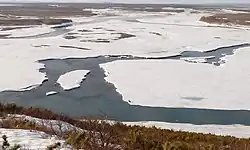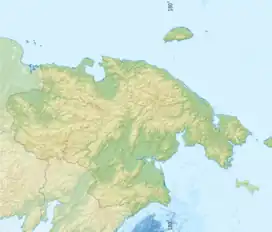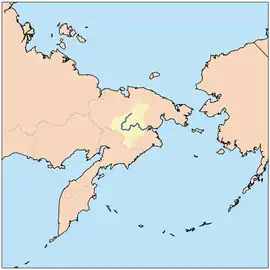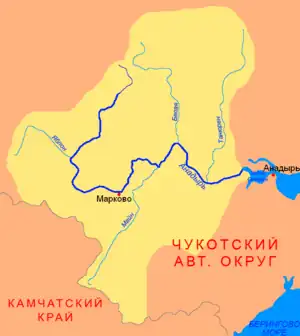| Anadyr Анадырь / Онандырь / Йъаайваам | |
|---|---|
 Confluence of the Anadyr and the Belaya | |
 Mouth location in Chukotka, Russia | |
| Location | |
| Country | Siberia, Russian Federation |
| Physical characteristics | |
| Source | |
| • location | Anadyr Highlands |
| • coordinates | 67°03′00″N 170°50′47″E / 67.0501°N 170.8464°E |
| • elevation | 504 m (1,654 ft) |
| Mouth | Bering Sea |
• location | Gulf of Anadyr |
• coordinates | 64°52′24″N 176°17′18″E / 64.8732°N 176.2882°E |
• elevation | 0 m (0 ft) |
| Length | 1,150 km (710 mi) |
| Basin size | 191,000 km2 (74,000 sq mi) |
| Discharge | |
| • location | Anadyr Estuary, Gulf of Anadyr |
| • average | 2,020 m3/s (71,000 cu ft/s)[1] |
| Basin features | |
| Tributaries | |
| • left | Belaya, Tanyurer |
| • right | Yablon, Yeropol, Mayn |
The Anadyr (Russian: Ана́дырь; Yukaghir: Онандырь; Chukot: Йъаайваам) is a river in the far northeast of Siberia which flows into the Gulf of Anadyr of the Bering Sea and drains much of the interior of Chukotka Autonomous Okrug. Its basin corresponds to the Anadyrsky District of Chukotka.
Geography
The Anadyr is 1,150 kilometres (710 mi) long and has a basin of 191,000 square kilometres (74,000 sq mi).[2][3] It is frozen from October to late May and has a maximum flow in June with the snowmelt. It is navigable in small boats for about 570 kilometres (350 mi) to near Markovo. West of Markovo it is in the Anadyr Highlands (moderate mountains and valleys with a few trees) and east of Markovo it moves into the Anadyr Lowlands (very flat treeless tundra with lakes and bogs). The drop from Markovo to the sea is less than 100 feet (30 m).
It rises at about 67°N latitude and 171°E longitude in the Anadyr Highlands, near the headwaters of the Maly Anyuy, flows southwest receiving the waters of the rivers Yablon and Yeropol, turns east around the Shchuchy Range and passes Markvovo and the old site of Anadyrsk, turns north and east and receives the Mayn from the south, thereby encircling the Lebediny Zakaznik, turns northeast to receive the Belaya from the north in the Parapol-Belsky Lowlands, then past Ust-Belaya it turns southeast into the Anadyr Lowlands past the Ust-Tanyurer Zakaznik and receives the Tanyurer from the north. At Lake Krasnoye, it turns east and flows into the Onemen Bay of the Anadyr Estuary. If the Onemen Bay is considered part of the river, it also receives the Velikaya from the south and the Kanchalan from the north. Other important tributaries are the Yablon, Yeropol and Mamolina from the right and the Chineyveyem and Ubiyenka from the left.[4]
Its basin is surrounded by the Amguema and Palyavaam basins to the north, the Bolshoy Anyuy, Oloy and Kolyma basins to the northwest, and the Penzhina basin to the southwest.
 Location of the Anadyr |
 Basin of the Anadyr with its main tributaries |
History
In 1648, Semyon Dezhnev reached the mouth of the Anadyr after being shipwrecked on the coast. In 1649, he went upriver and built winter quarters at Anadyrsk. For the next 100 years, the Anadyr was the main route from the Arctic to the Pacific and Kamchatka. In the 18th century, the Anadyr was described by the polar explorer Dmitry Laptev.
Ecology
The country through which it passes is thinly populated, and is dominated by tundra, with a rich variety of plant life.[lower-alpha 1] Much of the region's landscapes are dominated by rugged mountains. For nine months of the year the ground is covered with snow,[5] and the frozen rivers become navigable roads. George Kennan, an American working on the Western Union Telegraph Expedition in the late 1860s, found that dog sled travel on the lower Anadyr was limited by lack of firewood.
Reindeer, upon which the local inhabitants subsisted, were once found in considerable numbers,[lower-alpha 2] but the domestic reindeer population has collapsed dramatically since the reorganization and privatization of state-run collective farms beginning in 1992. As herds of domestic reindeer have declined, herds of wild caribou have increased.
There are ten species of salmon inhabiting the Anadyr river basin. Every year, on the last Sunday in April, there is an ice fishing competition in the frozen estuarine waters of the Anadyr's mouth. This festival is locally known as Korfest.
The area is a summering place for a number of migratory birds including brent geese, Eurasian wigeons, and the pintails of California.[6][7]
See also
Sources
Footnotes
Notes
- ↑ Christer, Nilsson; Catherine, Reidy, Liermann; Mats, Dynesius; Carmen, Revenga (2005). "Fragmentation and Flow Regulation of the World's Large River System". doi:10.1126/science.1107887.
{{cite web}}: CS1 maint: multiple names: authors list (link) - ↑ "Река Анадырь in the State Water Register of Russia". verum.wiki (in Russian).
- ↑ Анадырь (река на Чукотке), Great Soviet Encyclopedia
- ↑ "Water of Russia - Анадырь". Archived from the original on 2022-10-03. Retrieved 2023-04-24.
- 1 2 3 Chisholm 1911.
- ↑ Henny 1973, pp. 23–29.
- ↑ "Biologist's Journal 2001" Western Ecological Research Center, United States Geological Survey
References
- Chisholm, Hugh, ed. (1911). . Encyclopædia Britannica. Vol. 1 (11th ed.). Cambridge University Press. p. 907.
- Henny, Charles J. (January 1973). "Drought Displaced Movement of North American Pintails into Siberia". The Journal of Wildlife Management. 37 (1): 23–29. doi:10.2307/3799734. JSTOR 3799734.
- "Russian Far East Hot Spots". Wild Salmon Center. Nov 2, 2023. Archived from the original on Oct 18, 2007. Retrieved Nov 2, 2023.
External links
- "Tourist and environmental information" Archived 2010-09-01 at the Wayback Machine Chukotka Autonomous Okrug website, in English
- "Russia Far East: Anadyr River" Wild Salmon Center
- "Snezhnoye: a village on the Anadyr' River"